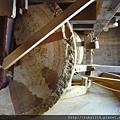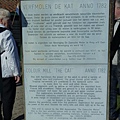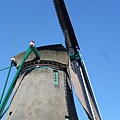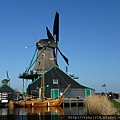Below information is from http://www.zaanschemolen.nl
DE KAT (The Cat)
Dye mill on the Kalverringdijk
Zaanse Schans, Zaandam, The Netherlands
This windmill is a smock mill: only the cap with its sails are turned to face the wind by means of the capstan wheel at the bottom of the tail-pole. The horizontal rotary motion of the sails is converted into vertical rotary motion movement by the brake wheel and the wallower in order to power the machinery on the floor below. The brake wheel is surrounded by a wooden brake which makes it possible to stop the mill from turning.
The Zaan
The story begins outside, just around the corner! There is the river Zaan. The people who lived along its banks, and who had grown rich through trade and fishing, built their first windmills around 1600. Initially they used the wind to keep their feet dry, but later on they used it to develop an entire industrial area. Barley, rice, paper, wood, cooking oil, mustard, tobacco, hemp and many other products were processed in 1,000 windmills in the Zaan area. From 1850 on the work of the windmills was taken over by soot-spewing steam engines. Only 13 windmills survived, as monuments of industry and technology.
The wind
It is the wind, a rather capricious source of energy, that makes our windmills work (or not work, as the case may be!). But they cannot work without the miller, who turns the sails, mounted on the 15-ton cap, into the face of the wind. He also regulates the speed of the windmill by means of the sails and boards.
Color
The product of this windmill is color - or rather, dyestuff! From 1600 onwards tropical dye woods were imported on a large scale in order to dye fabrics. They heavy pieces of wood were cut into chips by choppers in a big vat. The chips were then pulverized by edge runner stones weighing 5000 to 7000 kg and later sifted in a rotating drum. They were then packed into bales or barrels and delivered to the customers.
Just before 1700 the windmills were also put to use to process mineral dyes, chalk and abrasives. The wet stones, which came from quarries, first had to be dried off in warehouses. Painters made paint by rubbing the dye powders into a medium such as linseed oil.
Around 1920 there were only about 50 windmills left of the 1000 that had made the Zaan district the oldest industrial area of the world.




- Mar 27 Sun 2011 16:16
Zaanse Schans, Zaandam
close
全站熱搜
 留言列表
留言列表
發表留言



 留言列表
留言列表
